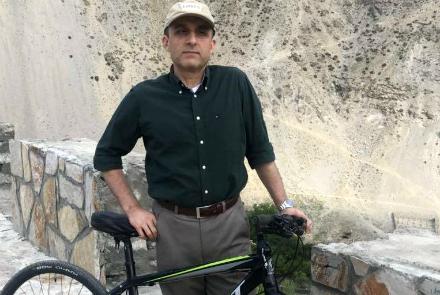On Sunday, Amrullah Saleh — who served as acting Interior Minister for just over a month and is running as the first Vice Presidential candidate in President Ghani’s re-election campaign —issued a challenge to the people of Afghanistan.
Taking to Twitter, Saleh said: “A challenge: Those who claim that terror groups controls nearly half of Afg are invited to visit my office in Kabul & join us for a tour of the country by road, by plane, by bike, on horse and by foot. This falsehood & fake news is mostly spread by stooges, agents & idiots.”
Saleh’s tweet was a reference to reports by the Special Investigator General for Afghanistan Reconstruction, the top US watchdog on Afghanistan, that the Afghan government continues to lose ground to the armed opposition.
In their most recent report, SIGAR said that the Afghan government controls or influences 53.8 percent of the nation’s 407 districts. The remaining areas are either under the influence or control of armed groups, including the Taliban or are considered to be ‘contested’ territories.
Saleh’s statement led to a swift and fiery backlash among Afghan social media users.
In the eight years since I returned to the country of my birth, I’ve traveled throughout Afghanistan. I’ve been to areas considered entirely under opposition control where residents warned me not to stay long for fear of drone strikes and air raids. I’ve also been to areas fully under government control where there is electricity and residents have to travel to neighboring countries — where they are subject to racism, intimidation and violence — for work.
Even with all my privileges — two passports, a dollar salary and access to high-level officials — I have seen just how difficult it can be to travel even a few kilometers into the districts of the province of Kabul. It is because of this that I was appalled by Saleh’s dismissal of the fears of millions of Afghans, whom he is indirectly (or possibly directly) accusing of working with the enemy or simply lacking intelligence.
The truth is, in this matter, it is Saleh who seems to be ill-informed.
Though as a journalist I don’t place much weight behind these statistics — too many districts trade hands far too often for it to be a true barometer of the actual reach of the Kabul government — the fact is that millions of Afghans cannot freely travel around their country.
Above all, it is important to remember that just because the government technically controls an area, it does not mean the people have access to even the most basic of services. In 2015, millions of residents in the city of Kabul went without power for nearly a month because battles between the Taliban and Afghan National Security Forces in Baghlan province led to the downing of at least three power pylons. This was of course, on top of the annual winter-time electricity shortages families must contend with in the Afghan capital.
The Asia Foundation’s 2017 Survey of the Afghan People found that 26 percent of respondents in the province of Kabul cited access to clean drinking water as the biggest problem facing their community. Entire swaths of road in the cities of Kabul and Jalalabad remain unpaved, even 18 years after the US-led intervention poured billions of dollars into reconstruction efforts. Currently, at least 1,000 schools are closed throughout the country. Though many of these schools are closed due to Taliban threats and policies, in 2016, Human Rights Watch documented at least 12 schools in Baghlan province being used by the ANDSF for military operations. A 2014 Medecins Sans Frontieres report said that one in five people surveyed in Kabul province traveled outside the country for medical care, due to lack of proper, affordable healthcare facilities.
Given these facts, I would invite Saleh to travel to these areas of Afghanistan, many of them within driving distance of his Kabul office, to see just how much people in territories considered fully under the control of the government still want for even the most basic of services.
As for traveling throughout the country “by road, by plane, by bike, on horse and by foot,” I have traveled across at least 17 of the nation’s provinces by road, plane, by motorbike and by foot, and I can assure Saleh that it is not nearly as easy his 221-character post would make it seem.
In the last seven years, I have made at least half a dozen trips to Bamiyan, considered to be one of the safest provinces in the country, by road. Initially, we would travel through Parwan, which would mean passing the Ghorband Valley, known to be home to several armed groups, including the Taliban.
In recent years, we would go through Maidan Wardak province, which meant traversing through 25 kilometers of a road where giant craters in the ground mark the site of an IED explosion and ANDSF do not venture outside their well-guarded facilities. What this means, is that for the thousands of people, making the journey to one of Afghanistan’s safest provinces requires them to choose between of the nation’s most dangerous roadways.
But it’s not just Bamiyan, Maidan Wardak and Parwan.
In the summer of 2015, I traveled by plane to Ghor, a remote and deprived province that is home to more than 130 different armed groups. At the time, I stayed in a local NGO office and asked if I could go to the historic Minaret of Jam. The answer I was given, highlighted a reality that seems to have escaped Saleh entirely.
“To get there means passing through more than a dozen checkpoints manned by any number of different armed groups on a road that is mostly unpaved. It would take you hours, and there’s no guarantees you’d make it there alive.”
In fact, I couldn’t venture outside of Chaghcharan, the provincial capital, due to security fears. That was one of the only times I ever experienced that in any province of Afghanistan.
Two years later, I traveled to the district of Shindad in Herat, though I went with a Herati journalist friend of mine, when we reached Adraskan, Police officials insisted we head to the Shindand district center (technically under government control) in their Humvees (which were phenomenally ill-equipped) and Rangers.
Not all my travels were for work, though.
In recent years, I have made multiple trips to Mosahi district in Kabul (which many local residents still refer to as part of Logar) and Mohammad Agha in Logar province.
When we used to travel to Mohammad Agha — we haven’t been able to go since 2015 — we always had to make sure to leave well before sunset to avoid Taliban checkpoints.
In Mosahi, now part of Kabul province, farmers told us they could not put a voter registration sticker on their Tazkira because of the Taliban presence in the area. In fact, just as we were discussing that issue, we heard the sounds of gunfire and explosions, which meant our trip back to Kabul would have to be further delayed.
These are just a few stories of my personal experiences, but the truth is, this country is full of millions of stories like this. Even in Kabul, I personally have dozens of friends and family who have not been able to return to their watan in Logar, Maidan Wardak, Paktia and Ghazni for several years (if not more than a decade) due to ongoing security concerns.
In the end, Saleh can imagine any scenario he wants to in his head or on his social media accounts, but the reality is that traveling through many parts of this country is truly a gamble. Every time we make these journeys, each one of us knows that we could face injury, kidnapping or death. We also know that these fates could come as a result of any number of factors ranging from the Taliban to other armed groups to bandits and kidnappers to drone and aerial strikes to IEDs. Regardless of who or what the danger emanates from, the fact is that for far too many people, moving around Afghanistan comes with any number of risks.
We certainly won’t die every time, but we all know that we very well could.
That is the truth of traveling in many parts of Afghanistan.
Anyone who claims otherwise is not only spreading fake news but is also putting the lives of millions of people at risk with their own false claims.


